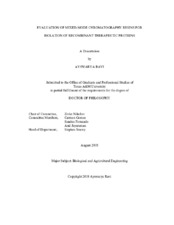| dc.description.abstract | Biotherapeutics are lifesaving drugs, but their cost is prohibitively high for widespread use. Multiple chromatography operations required to meet stringent regulatory standards, contributes up to 70% of manufacturing cost. Mixed-mode resins are emerging chromatographic media having multimodal chemistries promising enhanced process selectivity. Their potential to reduce the number of chromatography operations employed, is key to improving affordability of biotherapeutics. This dissertation assessed the capabilities of mixed-mode resins, using two recombinant therapeutic proteins with challenging purification needs. Mixed-mode ceramic hydroxyapatite (CHT) resin, was tested on microalgae, Chlamydomonas reinhardtii lysate, containing phosphorylated bone regenerative protein, osteopontin, in low purity (0.1-0.2% w/w). Complete binding of osteopontin to CHT through electrostatic interactions and Ca^2^+ coordination required 1500 mM sodium phosphate followed by 100 mM NaOH elution buffers to recover 86% of osteopontin. CHT distinguished between phosphorylated and non-phosphorylated Escherichia coli osteopontin, however, also co-purified impurity proteins (Rubisco) with similar properties. Versatility of mixed-mode resins was tested with osteopontin lacking phosphorylation, expressed intracellularly in E. coli. High-throughput screening of mixedmode resins, established HEA HyperCel as the capture chromatography promising 14- fold increase in purity. Interestingly, ensuing protein elution with NaCl from HEA HyperCel, the interaction with Capto Q resin was orthogonal resulting in 95% purity and 44% overall recovery. For the potential treatment of cystic fibrosis, human thioredoxin, was expressed in E. coli in high titers. HEA HyperCel resin bound thioredoxin at moderate conductivity of 5 mS and provided highest elution purity. However, unlike osteopontin, elution with NaCl buffer had the caveat of 45% thioredoxin recovery. Molecular modelling revealed existence of electrostatic and van der Waals interactions, supplementing experimental results. Simultaneous targeting of all interactions with 0.1 M arginine in 1 M NaCl buffer resulted in 100% recovery of biologically active, monomeric thioredoxin. This study established that mixed-mode resins fare well in capturing therapeutic proteins from complex lysates, irrespective of the expression titer. Their flexibility in binding conditions eliminate the processing cost and time associated with conditioning operations. However, the protein-ligand interaction is driven by the properties of the target protein and process development with a thorough understanding of interaction mechanism is essential to realize their maximum potential. | en |


